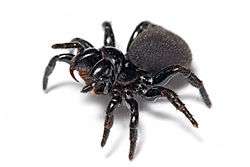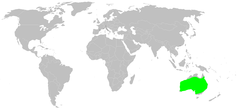Missulena bradleyi
| Missulena bradleyi | |
|---|---|
 | |
| Eastern mouse spider, Missulena bradleyi | |
| Scientific classification | |
| Kingdom: | Animalia |
| Phylum: | Arthropoda |
| Subphylum: | Chelicerata |
| Class: | Arachnida |
| Order: | Araneae |
| Infraorder: | Mygalomorphae |
| Family: | Actinopodidae |
| Genus: | Missulena |
| Species: | M. bradleyi |
| Binomial name | |
| Missulena bradleyi Rainbow, 1914[1] | |
 | |
Missulena bradleyi, also known as the eastern mouse spider, is a species of spider belonging to the family Actinopodidae. The spider is endemic to the east coast of Australia.[2][3]
William Joseph Rainbow described the eastern mouse spider in 1914, from a specimen collected in North Sydney by Henry Horton Burton Bradley (1845–1918), president of the Board of Trustees of the Australian Museum at the time. Describing the "beautiful and strikingly marked" specimen as a "decided novelty", Rainbow named it in honour of its collector, whom he stated was the first collector of Australian spiders.[4]
Eastern mouse spiders are often mistaken for Australian funnel-web spiders.[5] Their fangs often cross over while those of funnel-webs remain parallel,[6] and the latter often have a drop of venom on their fang tips.
Male eastern mouse spiders roam around in autumn and early winter looking for mates.[7] They sometimes fall into swimming pools in the process.[6] Cases of envenomations have peaked during this period.[8]
Common symptoms of eastern mouse spider bites are numbness and tingling at the bite site, as well as diaphoresis, headache and nausea generally. Although it appears to be the most dangerous member of the genus, serious envenomings by this species are relatively rare. Most bites documented in the medical literature did not require use of antivenom or involve serious symptoms. The venom of the eastern mouse spider has been found to have toxins similar to the robustoxin found in funnel-web venom; and funnel-web antivenom has been found to be effective in treating severe mouse spider bites. Compared to the funnel-web, however, the mouse spider is far less aggressive towards humans, and may often give "dry" bites.[8]
References
- ↑ "Taxon details Missulena bradleyi Rainbow, 1914". World Spider Catalog. Natural History Museum Bern. Retrieved 15 March 2016.
- ↑ "Mouse Spiders". Australian Museum. Retrieved 19 June 2013.
- ↑ "Mygalomorphae or primitive spiders". Retrieved 19 June 2013.
- ↑ Rainbow, William Joseph (1914). "Studies in Australian Araneidae. No. 6. The Terretelariae". Records of the Australian Museum. 10: 187–270 [268-70]. doi:10.3853/j.0067-1975.10.1914.901.
- ↑ "Mouse Spiders". Australian Museum. 14 November 2010. Retrieved 6 September 2013.
- 1 2 Queensland Museum (2013). "Mouse Spiders". Animals of Queensland. South Brisbane, Queensland: Queensland Government. Retrieved 6 September 2013.
- ↑ Australian Reptile Park (2010). "Mouse Spider". The Hands On Zoo. Somersby, New South Wales: self. Retrieved 6 September 2013.
- 1 2 Isbister, Geoffrey K (2004). "Mouse spider bites (Missulena spp.) and their medical importance". Medical Journal of Australia. 180 (5): 225–27.